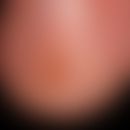Synonym(s)
HistoryThis section has been translated automatically.
DefinitionThis section has been translated automatically.
Hereditary lysosomal storage disease ( sphingolipidosis) caused by a defect in the lysosomal localized (see below lysosome) ß-glucosidase (glucocerebrosidase).
You might also be interested in
EtiopathogenesisThis section has been translated automatically.
Autosomal recessive inherited mutations of the ß-glucosidase gene (gene locus: 1q21), which lead to the absence of glucocerebrosidase, and by this enzyme deficiency to an increasing accumulation of glucocerebrosides among others in macrophages. Morphological characteristic is the Gaucher cell with a diameter of 20-100 µm, in which histochemically an accumulation of cerebrosides and electron-optically fine-membraned so-called "cytoplasmic bodies" are detectable.
These cause skin pigmentation and eyelid fissure stains (pingueculae). Cerebroside storage in the cellular elements of the reticulohistiocytic system, such as the spleen, liver, bone marrow and lymph nodes, is a consequence of cerebrosidase deficiency, while biosynthesis is normal. In addition to cerebroside, cytosides and hematosides are found, although to a lesser extent.
ClinicThis section has been translated automatically.
The first manifestations often occur in infancy, then mostly progressive neurological symptoms with cachexia, mental retardation and fatal end. In later manifestations in childhood or, less frequently, in adulthood, CNS involvement may be absent. The other findings are then in the foreground: hepatosplenomegaly with hematological abnormalities (anemia, leukopenia and thrombopenia) and increased bleeding and infection tendency, as well as bone damage. 3 forms can be distinguished:
- Chronic adult form without neurological symptoms: involvement of the haematopoietic system and bone.
- Acute malignant form with neurological symptoms: manifestation in the first years of life, progressive neurological symptoms.
- Subacute juvenile form with neurological symptoms: Same as 2nd but slower progression.
Skin symptoms mainly in chronic adult form and possibly in subacute juvenile form: Ochre-yellow-brown hyperpigmentation occurring mainly in exposed skin areas. On the lower legs reticular distribution pattern, in the face chloasma-like. Further small spots or streaks of pigmentation with a sharp border under the ankles. Hyperpigmentations in the conjunctiva. A subtype of this disease is characterised by severe congenital ichthyosis, which corresponds to the clinical picture of the " collodion baby".
DiagnosisThis section has been translated automatically.
Detection of enzyme defect (ß-glucosidase) in leukocytes or cultured fibroblasts.
Electron microscopy: detection of Gaucher cells in bone marrow or spleen punctate: macrophages with characteristic reticular fibrillar tangles in the cytoplasm.
External therapyThis section has been translated automatically.
Internal therapyThis section has been translated automatically.
LiteratureThis section has been translated automatically.
- Knox JHM et al (1916) Gaucher's disease (A report of two cases in infancy). Johns Hopkins Hosp Rep 17: 64
- Barton NW et al (1991) Replacement Therapy for inherited enzymes Deficiency - Macrophage targeted glucocerebrosidase for Gaucher's Disease. N Engl J Med 324: 1464-70
- Figueroa ML et al (1992) A less costly regimen of alglucerase treat gaucher's disease. N Engl J Med 327: 1632-36
- Gaucher PCE (1882) De l'epithelioma primitif de la rate, hypertrophy idiopathique de la rate sans leucemie. Faculte de Medecine, These de Paris 31
- Goker-Alpan O et al (2003) Phenotypic continuum in neuronopathic Gaucher disease: an intermediate phenotype between type 2 and type 3 J Pediatr 143: 273-276
- Mignot C et al (2003) Perinatal-lethal Gaucher disease. At J Med Genet 120A: 338-344
- Shitrit D et al (2003) D-dimer assay in Gaucher disease: correlation with severity of bone and lung involvement. Am J Hematol 73: 236-239
- Weinreb NJ et al (2002) Effectiveness of enzyme replacement therapy in 1028 patients with type 1 Gaucher disease after 2 to 5 years of treatment: a report from the Gaucher Registry. At J Med 113: 112-119
Incoming links (18)
ACP5 Gene; Autophagy-gene; Beta-mannosidosis; Ccl18; Cerebroside lipoidosis; Dyschromatosis universalis hereditaria; GBA 2 gene; Glucocerebrosidosis; Interstitial lung diseases; Lipid deposition diseases, systematized; ... Show allOutgoing links (6)
Collodion baby; Hydroquinone; Light stabilizers; Lysosome; Melasma; Sphingolipidoses;Disclaimer
Please ask your physician for a reliable diagnosis. This website is only meant as a reference.




